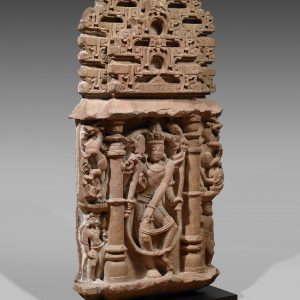Bodhisattva Maïtreya head
28 000,00€
Schist
1st-3rd century
Ancient Gandhāra region
H. 24 cm or 9,4 inch
360° view
Description
The Bodhisattva, an image of compassion
This schist sculpture depicts the Bodhisattva Maïtreya, one of the most popular in the Buddhist tradition. The Bodhisattva is recognisable by his lākṣaṇa or Great Man signs, which equate him with a Buddha of the future. These include his cranial protuberance, the uṣṇīṣa, as well as his tuft of hair in the middle of his eyebrows, called the ūrṇā. These iconographic codes become fixed in the early centuries of our era, at the same time as the first occurrences of anthropomorphic representations of the Buddha appear, thus breaking with a long aniconic tradition.
A new art
This paradigm shift originated in the development of a new religious trend, Mahāyāna Buddhism, also known as Great Vehicle Buddhism. Bodhisattvas play a major role in this religious trend, and intervene as intercessors with the faithful. These Buddhas of the future, who delay the moment of their awakening in order to help the devotees in their spiritual quest, particularly favour the growth of this religious current. The latter now reaches a larger number of followers and is no longer reserved for an austere monastic elite. Like Mahāyāna Buddhism, religious art is based on a sensitive approach to representations, playing on the connivance with the faithful. The images of the Bodhisattva embody compassion, and the gentle art thus turns away from the elite. The statuary production ofthe Gandhāra, of which this head is a part, covers the fervent religious reality of the early centuries of our era in this region. The sculptors inspire vitality in their works through a very sensitive treatment of flesh and modelling. The aim is to strike the soul of the spectators, to impress them, in a permanent search for the best way to touch the faithful, in particular through the images of the Bodhisattva, full of humanity.
The syncretism of images
Maitreya has a regular face, a fine, straight nose, a full chin, and a delicately hemmed mouth topped by a thin, soft, curly head of hair, the strands of which are pulled back from the skull. All these elements are part of Hellenistic art, and testify to the settlement of Greeks in the region. His large eyes, with pupils incised in the form of spirals, are placed under prominent superciliary arches, thus contributing to the realism and vivacity of his gaze, in an effort to humanise the religious images.
His curly moustache, finely detailed with slight incisions, bears witness to the fashion of the Kuṣāṇa elite. The latter were often represented in the guise of Bodhisattva, becoming privileged subjects for the projection of their power. Coming from Central Asia, the Kuṣāṇa rulers (1st-3rd centuries) were the main patrons within this geographical area, and it was under their impetus that the art of the Gandhāra underwent a formidable development. It was a real empire, which included territories from Uzbekistan to North India. This powerful kingdom was at the crossroads of many influences, notably from its Greek neighbours -successors of Alexander -in Central Asia, and then from the Roman Empire, which conquered these territories. This syncretic style, so original in Buddhist art, enjoyed great posterityin the Gandhāra, thus ensuring its popularity.
Provenance: former French private collection, before 1970, by repute.











